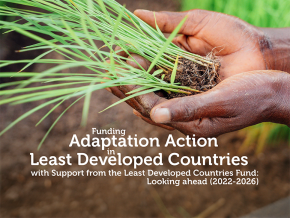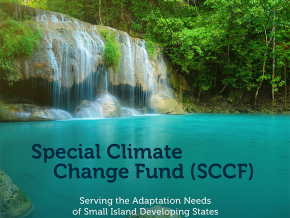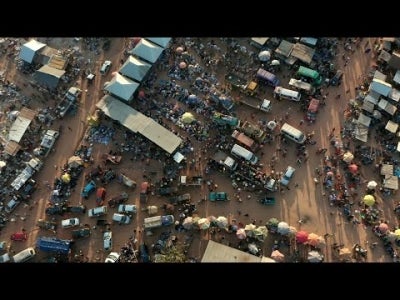The best of both worlds: Embracing environmental protection in pursuit of prosperity in the Democratic Republic of Congo

It’s illegal to cut down mangroves to make charcoal in the Democratic Republic of Congo. Everybody knows it.
The problem is, in a country where more than 4.6 million children are acutely malnourished and over 90 percent of people don’t have enough food to eat, many people simply don’t feel they have a choice in the matter.
Cutting down mangroves means money or light or heat for cooking. Cutting down mangroves means survival.
But it doesn’t have to be that way.
And fortunately things are changing...
“The people of the DRC are finding new ways to diversify the way they earn money - and they are doing it with both ingenuity and drive", says Clotilde Goeman, a Regional Technical Advisor in climate change adaptation with the UN Development Programme.
“Their efforts are a remarkable testament to the resilience of the human spirit and the ambition to leave no one behind in efforts to end poverty and hunger.
“While pursuing sustainable livelihoods, they are combatting the impacts of climate change by boosting protective ecosystems such as the mighty mangrove forests.”
How are they doing it?

Setting the Market
Meet Achilles. Achilles is a young man who used to chop down mangroves to make charcoal, to supplement his income as an ironsmith.
Now, with training, Achilles has learned to manufacture energy-efficient stoves.
Achilles, along with other villagers, received his training under the Coastal Resilience Project, a five year initiative led by the Congolese Government with support from the UN Development Programme.
Funded through the Global Environment Facility Least Developed Countries Fund (GEF-LDCF), the project has made important strides in educating local communities about the economic and environmental importance of mangroves, as well as their role in protecting vulnerable coastal areas from sea-level rise.
Achilles doesn’t have to chop down mangroves to make a living any more. In fact, through his own ingenuity, Achilles has created a new market that is transforming the way people buy and manufacture stoves in this part of DRC.
“I used to produce lockers and cut mangroves for charcoal for a living. Last year, I received training from the Coastal Resilience Project on how to produce improved stoves. Since the training, I’ve further enhanced the technique and adapted it to the local conditions.” - Achilles
The highly efficient cookstoves reduce the amount of charcoal required to cook a meal by 60 percent while at the same time reducing harmful smoke that can cause cancer and serious lung diseases.
Achilles’ design used the original prototypes that were given to 100 people in the villages of Nsiamfumu, Banana and Muanda, but used slightly different materials to protect the stoves from the salty air and improved the design to make them more resistant.
“With this, I’ve already managed to sell 17 improved stoves, for 25,000 Congolese Franks (around US$15) each. There is a large demand and we produce better quality stoves for a price far cheaper to the price in Kinshasa, [which cost about US$30 each],” said Achilles.

Double Impact
By improving the efficiency of these stoves and providing alternative livelihoods, the project is taking important steps to protect the mangrove forests surrounding the villages of Muanda and Banana. There’s a vast mangrove forest here, much of which is protected by the Mangrove Marine Park.
Beside protecting important species such as the leatherback turtle and manatee, the mangrove forests of the Democratic Republic of Congo are important ecosystems that can capture carbon dioxide and support the nation in achieving its Nationally Determined Contributions to the Paris Agreement.
But most importantly, mangroves are reducing the strength and impact of waves on the shore (in particular through its roots outside of the soil), and reducing erosion by stabilizing the coast (through its roots inside the soil).
Unfortunately, since the year 2000 Central Africa has been losing its carbon-rich mangroves at an alarming rate of about 1.7 percent per year. Over a decade, this means that over 77,000 hectares of this vital ecosystem will be lost – that’s almost 300 square miles.
“On DRC’s coastal area, income generating activities are extremely limited: we can either be fishermen, extract rocks on the coast to sell them, or produce charcoal with local woods, including mangroves. Even though we observe the risk these activities can have on our coast, as long as we have no other options available, we will have to continue,” Nombe Luemba, one young project participant from the village of Nsiamfumu.

From Banana to Muanda, embracing new ways of doing things
On the coast between Banana and Muanda, estimates indicate that as much as 2.3 kilometers of fragile coast coastline have been lost since 1980, as a result of illegal sandmining and unsustainable boat docking. (Fishing is another important livelihood in the DRC, and the construction of a new boat dock is currently being studied by the project, another important step in reducing coastal erosion in the region.)
To protect the coastline and provide new income streams, the project is supporting local enterprisers to build fish farms along the mangroves.
To date, nine ponds have been installed across three villages (three per village). One promising sign that underscores the sustainability of these initiatives is that locals have decided to install an additional pond using their own money.
In Banana, which sits just on the edge of the Mangrove Marine Park, locals decided to place the aquaculture pond in a section of the mangrove forest that was used for illicit charcoal production.
“Even though we knew this is forbidden, we used to use this area to produce charcoal from mangroves. When the project team told us that we needed to allocate some space for aquaculture, we proposed this area.” – Chief of Zinga Bazonga village
In addition to the fish farms, the project has also supported communities in building three new market gardens that are using improved cabbage, tomato, nightshade, cucumber, eggplant, amaranth and spinach seed to boost climate resilience and production. The market gardens now provide new income streams for around 195 women.
“Not only will the new farms support food security in households along this coast, they have also had some interested flow-on effects that transforming local social constructs around gender.” – Clotilde Goeman, UNDP Regional Technical Advisor
The new fish farms and markets are seeing some other shifts...
Along this coast, men and women seldom mix. Men go to sea to fish, women tend to household chores, take care of the kids and mind the farm.
With the new opportunities to make money, men have shown an increased interest in helping with agriculture as well as tending to the maintenance of the fish farms.
This has provided women with more free time and economic empowerment, a crucial foundation to achieving gender equality.

The Journey Continues
In the end, improved stoves and fish farms are just one step toward achieving DRC’s goals to reduce poverty, end hunger, ensure gender equality, and to protect life on land and at sea (including through through more effective climate actions).
But first steps go a long way.
“Connected with other government-led initiatives supported through the United Nations Development System, these first steps will pave the way to mainstream and accelerate climate actions in the DRC, and build a future where environmental protection and economic prosperity go hand-in-hand.” – Clotilde Goeman
This story was originally published by UNDP.
FOOTNOTES: Story by UNDP Democratic Republic of Congo with Greg Benchwick and Clotilde Goeman. Photos by Clotilde Goeman except where otherwise cited.


